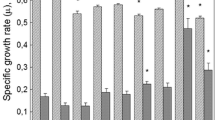Abstract
The intracellular concentrations of total glutathione, GSSG and protein · S-SG, the total excreted glutathione concentration, and the susceptibility towards GSH-reacting compounds were assayed in strains of Escherichia coli deficient in biosynthesis and/or reduction of glutathione. A deficiency in glutathione reductase displaced the glutathione status towards the oxidized forms. This displacement was more clearly appreciated in strains additionally deficient in glutathione biosynthesis. A deficiency in catalase activity also produced an increase in the oxidation of glutathione. The most severe changes were observed in the concentrations of protein-glutathione mixed disulfides and in the amount of glutathione excreted to the medium. Increased sensitivities towards compounds known to interact with cellular GSH were observed in glutathione reductase deficient strains, although these effects were enhanced in strains additionally deficient in GSH biosynthesis
Similar content being viewed by others
References
Kosower NS, Kosower EM: The glutathione status of cells. Int Rev Cytol 54:109–160, 1978.
Meister A, Anderson ME: Glutathione. Ann Rev Biochem 52:711–760, 1983.
Ziegler DM: Role of reversible oxidation-reduction of enzyme thiols-disulfides in metabolic regulation. Ann Rev Biochem 54:305–329, 1985.
Apontoweil P, Berends W: Isolation and initial characterization of glutathione-deficient mutants of Escherichia coli K12. Biochim Biophys Acta 399:10–22, 1975.
Fuchs JA, Warner HR: Isolation of an Escherichia coli mutant deficient in glutathione synthesis. J Bacteriol 124:140–148, 1975.
Murata K, Tani K, Kato J, Chibata I: Isolation of Escherichia coli B mutant deficient in glutathione biosynthesis. Agric Biol Chem 45:2131–2132, 1981.
Murata K, Kimura A: Some properties of glutathione biosynthesis-deficient mutants of Escherichia coli B. J Gen Microbiol 128:1047–1052, 1982.
Davis NK, Greer S, Jones-Mortimer MC, Perham RN: Isolation and mapping of glutathione reductase-negative mutants of Escherichia coli K12. J Gen Microbiol 128:1631–1634, 1982.
Barbado C, Ramirez M, Blanco MA, López-Barea J, Pueyo C: Mutants of Escherichia coli sensitive to hydrogen peroxide. Current Microbiol 8:251–253, 1983.
Fuchs JA, Haller B, Tuggle CK: Mutants of Escherichia coli altered in glutathione metabolism. In: Larsson A, Orrenius S, Holmgreen A, Mannervik B (eds). Functions of glutathione: biochemical, physiological, toxicological and clinical aspects. Raven Press, New York, 1983, pp 385–393.
Tuggle CK, Fuchs JA: Glutathione reductase is not required for maintenance of reduced glutathione in Escherichia coli K-12. J Bacteriol 162:448–450, 1985.
Miller JH: Experiments in Molecular Genetics. Cold Spring Harbor Laboratory, Cold Spring Harbor, New York, 1972.
Davis BD, Mingioli ES: Mutants of Escherichia coli requiring methionine or vitamin B12. J Bacteriol 60:17–28, 1950.
Snoke JE, Bloch K: Enzymatic synthesis of glutathione. Meth Enzymol 2:342–346, 1955.
Mooz ED, Meister A: Glutathione biosynthesis. Meth Enzymol 17B:483–495, 1971.
Tietze F: Enzymic method for quantitative determination of nanogram amounts of total and oxidized glutathione: applications to mammalian blood and other tissues. Anal Biochem 27:502–522, 1969.
Lowry OH, Rosebrough NJ, Farr AL, Randall RJ: Protein measurement with the Folin-Phenol reagent. J Biol Chem 193:263–275, 1951.
Akerboom TPM, Sies H: Assay of glutathione, glutathione disulfide and glutathione mixed disulfides in biological samples. Meth Enymol 77:373–382, 1981.
Harding JJ: Free and protein-bound glutathione in normal and cataractous human lenses. Biochem J 117:957–960, 1970.
Harrap KR, Jackson RC, Riches PG, Smith CA, Hill BT: The occurrence of protein-bound mixed disulfides in rat tissues. Biochim Biophys Acta 310:104–110, 1973.
Voetman AA, Loos JA, Roos D: Changes in the levels of glutathione in phagocytosing human neutrophils. Blood 55:741–747, 1980.
Sies H, Gerstenecker C, Menzel H, Flohe L: Oxidation in the NADP system and release of GSSG from hemoglobinfree perfused rat liver during peroxidatic oxidation of glutathione by hydroperoxides. FEBS Lett 27:171–175, 1972.
Pinto RE, Duarte MF, Roda-Santos ML: Aerobic glutathione oxidation and catalase activity in hepatomous liver of rats treated with diethylnitrosamine. IRCS Med Sci Biochem 8:97, 1980.
Smith IK, Kendall AC, Keys AJ, Turner JC, Lea PJ: Increased level of glutathione in a catalase-deficient mutant of barley (Hordeum vulgare L.) Plant Sci Lett 37:29–33, 1984.
Boveris A, Sies H, Martino EE, Docampo R, Turrens IF, Stoppani AOM: Deficient metabolic utilization of hydrogen peroxide in Trypanosoma cruzi. Biochem J 188:643–648, 1980.
Jocelyn PC: Biochemistry of the -SH group. Academic Press, New York, 1972.
Eneanya DI, Bianchine JR, Duran DO, Andresen BD: The actions and metabolic fate of disulfiram. Ann Rev Pharmacol Toxicol 21:575–596, 1981.
Goldberg B, Stern A: The generation of O2 − by the interaction of the hemolytic agent, phenylhydrazine, with human hemoglobin. J Biol Chem 250:2401–2403, 1975.
Singer B, Kuśmierek JT: Chemical mutagenesis. Ann Rev Biochem 52:655–693, 1982.
Srivastava SK, Awasthi YC, Beutler E: Useful agents for the study of glutathione metabolism in erythrocytes. Organic hydroperoxides. Biochem J 139:289–295, 1974.
Clarkson TW: The pharmacology of mercury compounds. Ann Rev Pharmacol Toxicol 12:375–406, 1972.
Author information
Authors and Affiliations
Rights and permissions
About this article
Cite this article
Alonso-Moraga, A., Bocanegra, A., Torres, J.M. et al. Glutathione status and sensitivity to GSH-reacting compounds of Escherichia coli strains deficient in glutathione metabolism and/or catalase activity. Mol Cell Biochem 73, 61–68 (1987). https://doi.org/10.1007/BF00229377
Received:
Issue Date:
DOI: https://doi.org/10.1007/BF00229377



